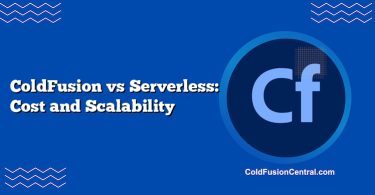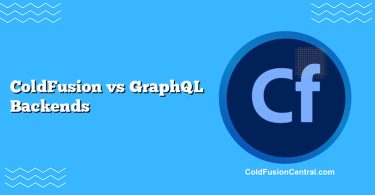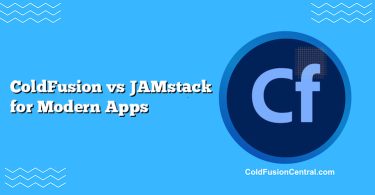Definitions
-
ColdFusion (CFML application server): A rapid application development platform and runtime (from Adobe; Lucee is the leading open-source implementation) that runs on the JVM. It provides built-in tools to create REST APIs, handle database access, caching, security, and templating using the CFML language. In this context, ColdFusion is the backend engine that implements REST services.
-
API Gateways (API management layer): A category of products and services (e.g., AWS API Gateway, Apigee, Kong, NGINX, Tyk, Azure API Management) that sit between clients and one or more backend services. Gateways centralize cross-cutting concerns like routing, rate limiting, authentication/authorization, request/response transformation, analytics, and lifecycle management of APIs.
Overview
ColdFusion and API Gateways address different layers of the REST services stack:
- ColdFusion focuses on building and running the service logic. It’s the implementation layer for your REST endpoints.
- API Gateways focus on exposure, control, and governance of those endpoints—things like traffic throttling, API keys, OAuth, observability, and developer onboarding.
They are not mutually exclusive. A common architecture is: Client → API Gateway → ColdFusion services (or other microservices).
Key Features
ColdFusion (Adobe ColdFusion, Lucee)
- Built-in REST support via annotations and configuration.
- CFML language for rapid server-side development.
- Integrated database access (CFQuery), caching, scheduling, PDF/reporting, mail, and file services.
- Session management, application scopes, and security features (e.g., password hashing, ESAPI functions).
- Runs on the JVM; easy integration with Java libraries.
- Can be deployed on-premises, in VMs, or containers; suitable for monoliths or macroservices.
API Gateways (Apigee, AWS API Gateway, Kong, NGINX, Azure APIM, Tyk)
- Centralized routing, canary releases, blue/green deployments.
- Authentication and authorization: API keys, OAuth2, JWT validation, mTLS.
- Rate limiting, throttling, quotas, and spike arrest.
- Request/response transformations (header, URL, payload mapping), versioning, deprecation policies.
- Observability: logs, metrics, traces, dashboards, API analytics.
- Developer portal, SDK generation, monetization, and policy enforcement.
- WAF integration and protection against common attacks (OWASP Top 10).
- Works across polyglot backends (ColdFusion, Node.js, Java, .NET, Go, Python).
Architecture and How They Fit Together
- Step 1: Implement the API.
- Use ColdFusion to implement endpoints (controllers/handlers), data access, business rules, and validations.
- Persist data using CFQuery or ORM; add CF caching for hot reads.
- Step 2: Front the API with a gateway.
- Configure a gateway to route /v1/… to your ColdFusion service.
- Apply policies: authentication (OAuth/JWT), rate limits, IP allowlists, and response caching.
- Publish documentation via OpenAPI; onboard consumers through a developer portal.
- Step 3: Operate and scale.
- Scale ColdFusion instances horizontally behind a load balancer.
- Use gateway analytics and logs for SLOs, error budgets, and performance tuning.
- Version APIs and manage lifecycle through the gateway; implement CI/CD for the ColdFusion code and gateway policies.
Result: ColdFusion remains focused on domain logic; the gateway enforces governance and experience for consumers.
Performance
- ColdFusion:
- CFML compiles to Java bytecode; performance is typically adequate for business apps.
- Latency depends on code design, DB queries, caching, and JVM tuning.
- For low-latency, high-throughput scenarios, careful optimization and horizontal scaling are key.
- API Gateways:
- Add a small, predictable hop (typically 1–10 ms in well-tuned self-hosted gateways; managed cloud gateways may add variable egress/ingress latencies).
- Can improve observed performance due to edge caching, compression, and connection reuse.
- Support for circuit breakers and retries improves perceived availability at scale.
Rule of thumb: Gateways add minimal overhead but return outsized benefits in reliability and production control.
Scalability
- ColdFusion:
- Scale up (larger JVM) or out (more instances behind a load balancer).
- Externalize session state (e.g., Redis) or use stateless design for easier horizontal scaling.
- Use CF distributed caching and tune JDBC pools for DB bottlenecks.
- API Gateways:
- Independently scalable tier, often stateless and horizontally scalable.
- Smooths traffic bursts with rate limiting and buffering.
- Facilitates multi-region and edge proximity deployments; supports global routing with DNS/Anycast.
Together: Gateway manages ingress and burst control; ColdFusion scales behind it.
Security
- ColdFusion:
- Built-in functions to mitigate common vulnerabilities; supports secure session management and parameter validation.
- Relies on developer discipline and platform security updates.
- TLS typically terminated at a reverse proxy/load balancer.
- API Gateways:
- Centralized authN/authZ: API keys, OAuth2, OIDC, JWT validation, mTLS between gateway and services.
- Protection policies: WAF, bot detection, IP/CIDR filtering, schema validation.
- Secrets management integrations and detailed audit trails.
Enterprises usually standardize security at the gateway layer and keep service-level security minimal and consistent.
Cost and Licensing
- ColdFusion:
- Adobe ColdFusion: commercial licensing per CPU/core or server, plus support. Good ROI for teams valuing productivity and vendor support.
- Lucee: open-source; cost is primarily infrastructure and optional commercial support.
- API Gateways:
- Managed services (e.g., AWS API Gateway, Apigee X/Azure APIM): pay-per-call or tiered plans; includes hosting and SLA.
- Self-hosted (e.g., Kong OSS/EE, Tyk, NGINX Plus): infrastructure + potential enterprise license.
- Hidden costs: developer time to manage policies, monitoring, security hardening.
Cost tends to correlate with scale and compliance requirements; gateways pay off when public exposure, SLAs, or multi-tenant control are needed.
Tooling and Developer Experience
- ColdFusion:
- Rapid development with CFML; tight feedback loop.
- Integrates with Java ecosystem and common CI/CD pipelines.
- Built-in tooling for caching, PDF, mail, and schedulers simplifies tasks.
- API Gateways:
- Policy-driven configuration; supports IaC (Terraform, OpenAPI-first).
- Developer portals, API catalogs, documentation generators.
- Observability integrations: Prometheus, OpenTelemetry, ELK, CloudWatch, Stackdriver.
Many teams adopt an OpenAPI-first workflow and generate client SDKs via the gateway.
Community Support and Ecosystem
- ColdFusion:
- Adobe CF: commercial support, regular updates, enterprise features.
- Lucee: active community, plugins, forums; broad JVM ecosystem compatibility.
- API Gateways:
- Large vendor and open-source communities; plugins/policies for standard patterns.
- Extensive learning resources on API management, security, and governance.
Use Cases and Scenarios
-
Prefer ColdFusion (alone or with minimal reverse proxy) when:
- Building internal, low-to-medium traffic REST services with few external consumers.
- You prioritize rapid delivery and already use CFML and JVM tooling.
- Governance requirements are light; a simple NGINX reverse proxy suffices.
- Example: An internal HR app exposes REST endpoints for payroll integration used by two internal systems only.
-
Prefer an API Gateway (fronting ColdFusion or other backends) when:
- Exposing APIs to partners or public developers; you need API keys, quotas, OAuth, and analytics.
- Operating many services or microservices across teams; you need consistent policy enforcement and versioning.
- Seeking monetization, developer portal onboarding, and SLAs.
- Example: A retail company exposes product, inventory, and order APIs to partners. A gateway enforces rate limits, signs JWTs, provides analytics, and manages API lifecycle; ColdFusion services handle business logic behind the gateway.
Side-by-Side Summary Table
| Aspect | ColdFusion (CFML App Server) | API Gateway (Apigee, AWS, Kong, etc.) |
|---|---|---|
| Primary role | Implement REST logic and data access | Manage, secure, and expose REST endpoints |
| Typical placement | Backend service runtime | Between clients and services (ingress) |
| Performance impact | Depends on code and JVM tuning | Adds small hop; can reduce perceived latency via caching/compression |
| Scalability | Scale app servers; externalize state | Scale gateway tier; global traffic control |
| Security | App-level validation and auth | Centralized authN/Z, WAF, mTLS, policies |
| Observability | App logs/metrics, needs setup | Built-in analytics, tracing, dashboards |
| Cost model | Adobe license or Lucee OSS + infra | SaaS pay-per-call or self-hosted license + infra |
| Best for | Rapid development of service logic | Governance, multi-tenant exposure, API lifecycle |
| Pros | Fast to build, rich JVM/CF tooling | Strong security, traffic control, analytics |
| Cons | Limited centralized governance | Operational complexity; added hop; costs |
Pros and Cons
ColdFusion
Pros:
- Extremely productive for building REST services quickly.
- Rich standard library and integrations (DB, cache, PDF, schedulers).
- Java interoperability; runs anywhere the JVM runs.
- Lucee provides a capable open-source option.
Cons:
- Without a gateway, teams must hand-roll or assemble security, rate limiting, and analytics.
- Scaling stateful apps requires careful design.
- Smaller talent pool relative to Node/Java/Go; training may be required.
API Gateways
Pros:
- Centralized security, rate limiting, quotas, and SLAs.
- Developer portal, versioning, and monetization streamline API programs.
- Robust observability and analytics; easier incident response and governance.
- Works with any backend stack; aids microservices evolution.
Cons:
- Adds operational layer and configuration complexity.
- Managed gateways can be costly at high volume.
- Additional network hop; careful tuning required to minimize latency.
Decision Factors / Which One Should You Choose?
-
Goal of the project:
- Build and iterate on business logic quickly? Favor ColdFusion for the implementation.
- Govern and expose APIs to many consumers with strict controls? Add an API Gateway.
-
Team and skills:
- Strong CFML/JVM expertise and internal consumption only? ColdFusion + simple proxy may suffice.
- Multiple teams, polyglot services, partner ecosystem? Gateway is key.
-
Security and compliance:
- Need OAuth2/OIDC, JWT, mTLS, WAF, and audit trails? Gateway.
- Minimal internal security needs? Handle in ColdFusion and network policies.
-
Scale and reliability:
- Anticipate bursts, global users, version churn? Gateway for rate limiting and gradual rollouts.
- Predictable internal load? ColdFusion scaling with a load balancer may be enough.
-
Cost sensitivity:
- Tight budget, internal endpoints: Lucee + NGINX is cost-effective.
- ROI from analytics, developer portal, and policy standardization: Gateway costs are justified.
Practical recommendation: Use ColdFusion to implement the API. Put an API Gateway in front when you expect external consumers, need governance or analytics, or want a standardized security posture. For small internal apps, a thin reverse proxy may be sufficient.
Supported Platforms and Interoperability
-
ColdFusion:
- Platforms: Windows, Linux; JVM-based deployments; container images available.
- Databases: Works with major RDBMS (Oracle, SQL Server, MySQL, PostgreSQL).
- Integration: Java libraries, messaging systems, REST/SOAP clients, email, file systems.
-
API Gateways:
- Deployment: Managed SaaS (AWS, GCP, Azure) or self-hosted Linux containers/VMs; some support Kubernetes/Ingress.
- Protocols: HTTP/1.1, HTTP/2, gRPC (varies by product), WebSockets (varies).
- Security: OAuth2/OIDC providers, JWT, mTLS, SAML (via IdP), WAFs, secrets stores.
Interoperability is strong: ColdFusion services can sit behind any modern gateway.
Key Takeaways
- ColdFusion and API Gateways solve different problems. One builds the service, the other manages its exposure.
- For professional REST API programs—especially external or multi-tenant—an API Gateway adds security, policy control, and analytics with minimal performance overhead.
- For internal, focused apps, ColdFusion alone can be ideal, delivering fast development and easy operations.
- The most resilient pattern is often both: ColdFusion behind a gateway, leveraging the strengths of each layer.
FAQ
Do I need an API Gateway if I only have one ColdFusion service used internally?
If traffic is small, consumers are trusted, and requirements are simple, you can run without a gateway using a reverse proxy (e.g., NGINX) and solid network controls. Revisit the decision if you add external consumers, need OAuth/JWT, quotas, or detailed analytics.
Can ColdFusion handle authentication and rate limiting on its own?
Yes, you can implement token validation, sessions, and simple throttling in ColdFusion. However, gateways provide these as standardized, centrally managed policies, which is preferable for multiple services or strict governance.
What’s the performance impact of adding a gateway in front of ColdFusion?
A well-tuned gateway typically adds a few milliseconds per call. In return, you gain caching, connection pooling, and resilience features that often improve overall reliability and perceived performance.
Is Lucee a viable alternative to Adobe ColdFusion for REST services?
Lucee is a strong, open-source CFML engine suitable for building REST APIs, with good performance and community support. Choose Adobe ColdFusion if you need specific enterprise features or vendor-backed support; choose Lucee for cost efficiency and flexibility.




